Study on the Influence of Borehole Heat Capacity on Deep Coaxial Borehole Heat Exchanger
Abstract
:1. Introduction
2. Semi-Analytical Model
3. Study on the Influences of Heat Capacities of Different Parts of Borehole
3.1. Study on the Influences of the Fluid Heat Capacity and Borehole Heat Capacity
3.2. Study on the Influences of the Pipe Heat Capacities and Grout Heat Capacity
4. Study on the Influences of Borehole Heat Capacity under Different Borehole Radii
5. Study on the Influences of Borehole Heat Capacity under Different Geothermal Gradients
6. Conclusions
- (1)
- The influence trends of the heat capacities of different parts of the borehole on the performance of DCBHE were basically the same, decreasing with the increase in time. In the early stage, ignoring the borehole heat capacity caused a deviation of about 4.24 °C to the fluid temperature. With the increase in time, the influence of ignoring the borehole heat capacity on the performance of DCBHE gradually weakened.
- (2)
- Among the heat capacities of different parts of the borehole, the impact of the fluid heat capacity on the performance of DCBHE was much greater than those of the heat capacities of the other parts, and the pipe heat capacities had the least impact on the performance of DCBHE. Under the working condition studied in this paper, the results obtained with considering the heat capacities of different parts of the borehole were compared to those ignoring heat capacities of the selected elements. It was found that ignoring the fluid heat capacity led to a 0.29 °C lower estimated outlet fluid temperature after 60 h. Omitting the heat capacities of pipes gave 0.03 °C, and not taking into account the heat capacity of grout gave a 0.13 °C lower outlet fluid temperature after 60 h, respectively.
- (3)
- When the borehole radius was larger, the borehole heat capacity had a greater impact on the performance of DCBHE. Under the working condition studied in this paper, ignoring the borehole heat capacity led to a 0.28 °C lower estimated outlet fluid temperature after 120 h for rb = 0.1 m, and to a 0.16 °C lower estimated outlet fluid temperature after 120 h for rb = 0.06 m.
- (4)
- For different geothermal gradients, the influences of borehole heat capacity on the performance of DCBHE were basically the same.
- (5)
- To sum up, the heat capacities of different parts of the borehole have an important impact on the performance of DCBHE, especially in the early stage and when the borehole radius is large.
Author Contributions
Funding
Institutional Review Board Statement
Informed Consent Statement
Data Availability Statement
Conflicts of Interest
References
- Zhao, Y.Z.; Ma, Z.B.; Pang, Z.H. A fast simulation approach to the thermal recovery characteristics of deep borehole heat exchanger after heat extraction. Sustainability 2020, 12, 2021. [Google Scholar] [CrossRef] [Green Version]
- Guan, C.M.; Zhao, S.W.; Zhang, W.K.; Sun, B.Y. Heat transfer analysis of ground heat exchangers for medium-deep geothermal energy heating. Heat. Vent. Air Cond. 2021, 51, 107–112. [Google Scholar]
- Zanchini, E.; Lazzari, S.; Priarone, A. Improving the thermal performance of coaxial borehole heat exchangers. Energy 2010, 35, 657–666. [Google Scholar] [CrossRef]
- Qi, Z.S.; Jiang, Y. Analysis of heat transfer characteristics for coaxial tubes underground heat exchanger. J. Jilin Inst. Archit. Civ. Eng. 2012, 29, 51–54. [Google Scholar]
- Wang, D.J.; Fang, L.; Hu, S.T.; Shao, Z.K.; Gao, Z.Y.; Diao, N.R. Parameter analysis of the performance of the deep borehole heat exchanger. Dist. Heat. 2018, 3, 1–7. [Google Scholar]
- Liu, J.; Cai, W.L.; Wang, F.H.; Wang, Z.H.; Han, E.S. Experimental study and tube structure optimization of deep borehole ground source heat pump. J. Eng. Thermophys. 2019, 40, 2143–2150. [Google Scholar]
- Li, Y.Q.; Xu, S.H.; Zhang, W.D.; Sun, Y.L.; Han, Y.L.; Zhang, H.; Huang, J.F. Thermal short-circuiting and heat transfer performance of coaxial borehole heat exchanger. Coal Geol. Explor. 2020, 48, 183–188. [Google Scholar]
- Du, T.T.; Man, Y.; Jiang, G.X.; Fang, L.; Fang, Z.H. Transfer modeling and heat extraction analysis of coaxial tubes deep borehole heat exchanger. Renew. Energy Resour. 2020, 38, 887–892. [Google Scholar]
- Bandyopadhyay, G.; Gosnold, W.; Mann, M. Analytical and semi-analytical solutions for short-time transient response of ground heat exchangers. Energy Build. 2008, 40, 1816–1824. [Google Scholar] [CrossRef]
- Lamarche, L.; Beauchamp, B. New solutions for the short-time analysis of geothermal vertical boreholes. Int. Heat Mass Transf. 2007, 50, 177–184. [Google Scholar] [CrossRef]
- Beier, R.A.; Spitler, J.D. Weighted average of inlet and outlet temperatures in borehole heat exchangers. Appl. Energy 2016, 174, 118–129. [Google Scholar] [CrossRef]
- Nguyen, A.; Pasquier, P.; Marcotte, D. Thermal resistance and capacity model for standing column wells operating under a bleed control. Renew. Energy 2015, 76, 743–746. [Google Scholar] [CrossRef]
- Li, M.; Lai, A.C.K. Analytical model for short-time responses of ground heat exchangers with U-shaped tubes: Model development and validation. Appl. Energy 2013, 104, 510–516. [Google Scholar] [CrossRef]
- Nian, Y.L.; Cheng, W.L. Analytical g-function for vertical geothermal boreholes with effect of borehole heat capacity. Appl. Therm. Eng. 2018, 140, 733–744. [Google Scholar] [CrossRef]
- Yang, X.Y.; Wang, G.D.; Wang, Q.S.; Chen, C.Q. Transient numerical model for a coaxial borehole heat exchanger with the effect of borehole heat capacity. Int. J. Energy Res. 2019, 43, 6551–6560. [Google Scholar] [CrossRef]
- Wang, C.L.; Lu, Y.H.; Chen, L.W.; Huang, Z.J.; Fang, H. A semi-analytical model for heat transfer in coaxial borehole heat exchangers. Geothermics 2021, 89, 101952. [Google Scholar] [CrossRef]
- Kong, Y.L.; Chen, C.F.; Shao, H.B.; Pang, Z.H.; Xiong, L.P.; Wang, J.Y. Principle and capacity quantification of deep-borehole heat exchangers. Chin. J. Geophys. 2017, 60, 4741–4752. [Google Scholar]
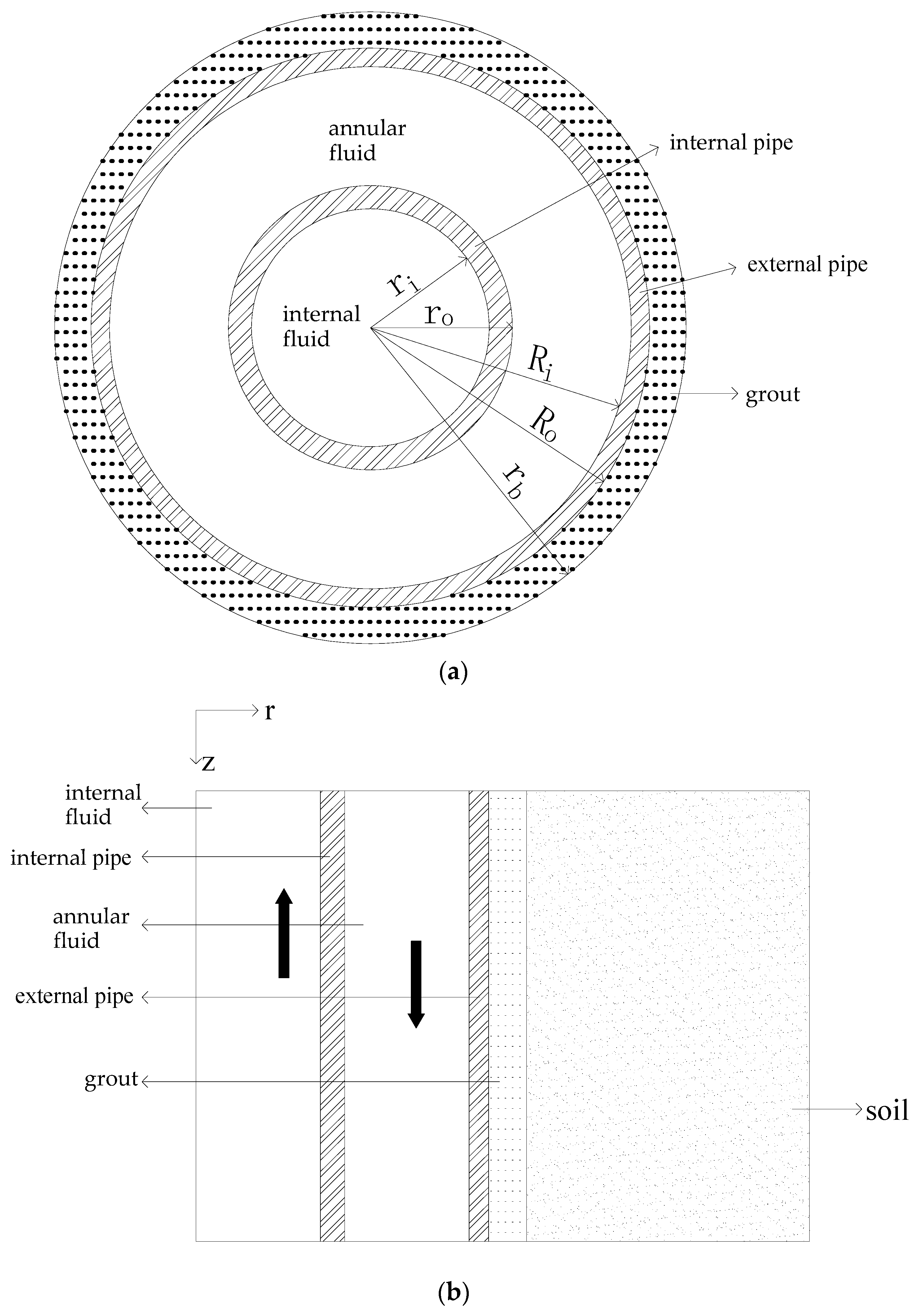
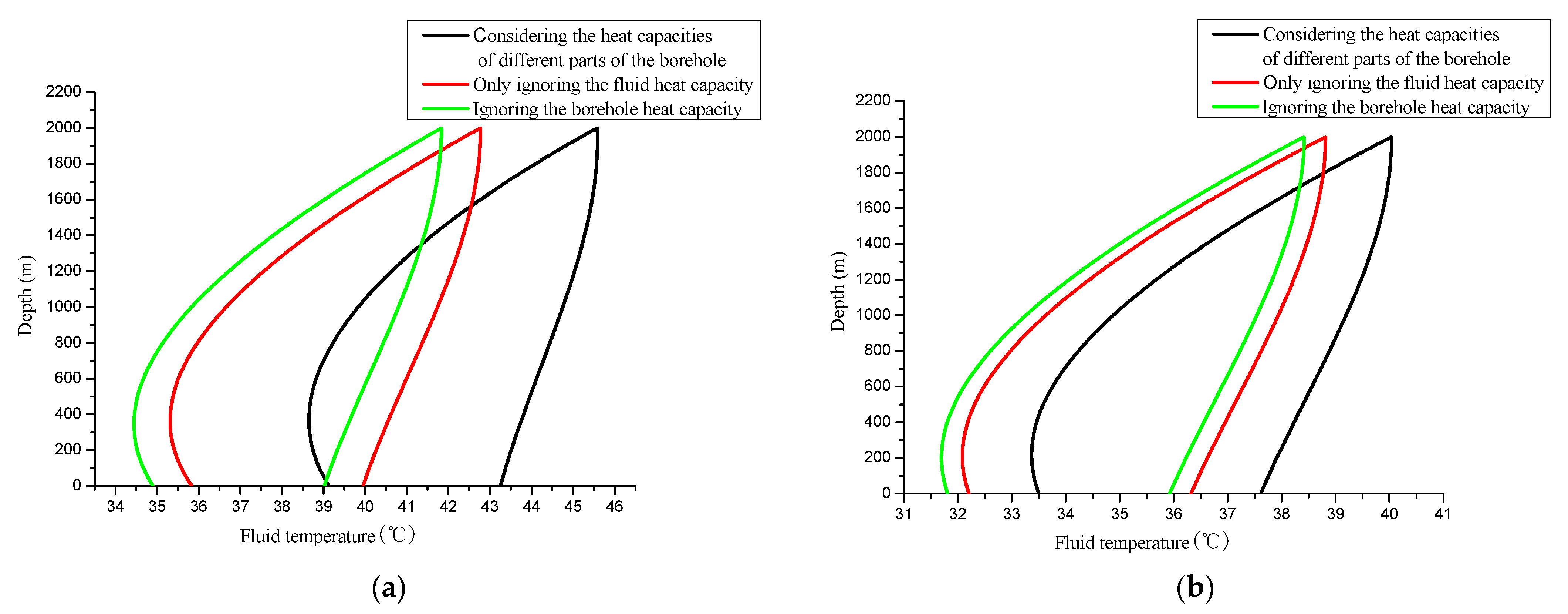
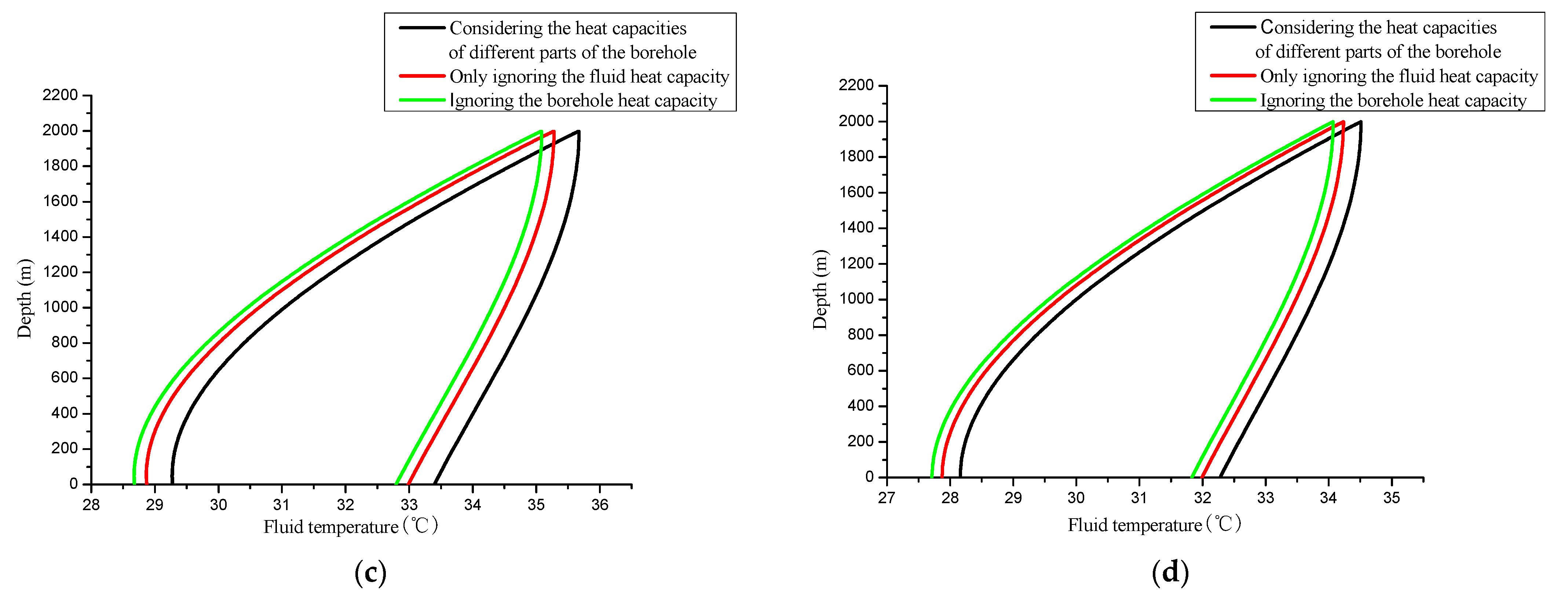
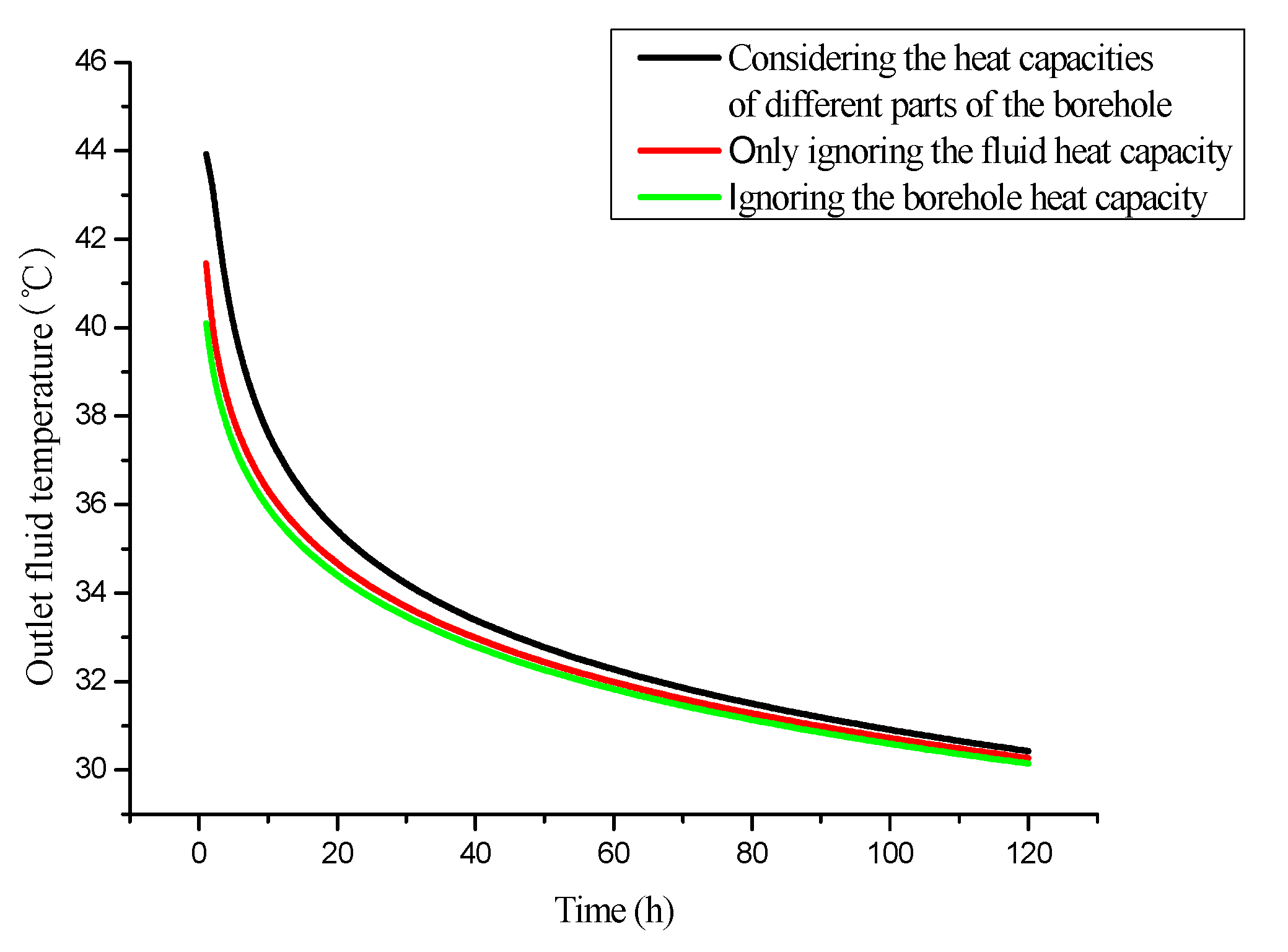
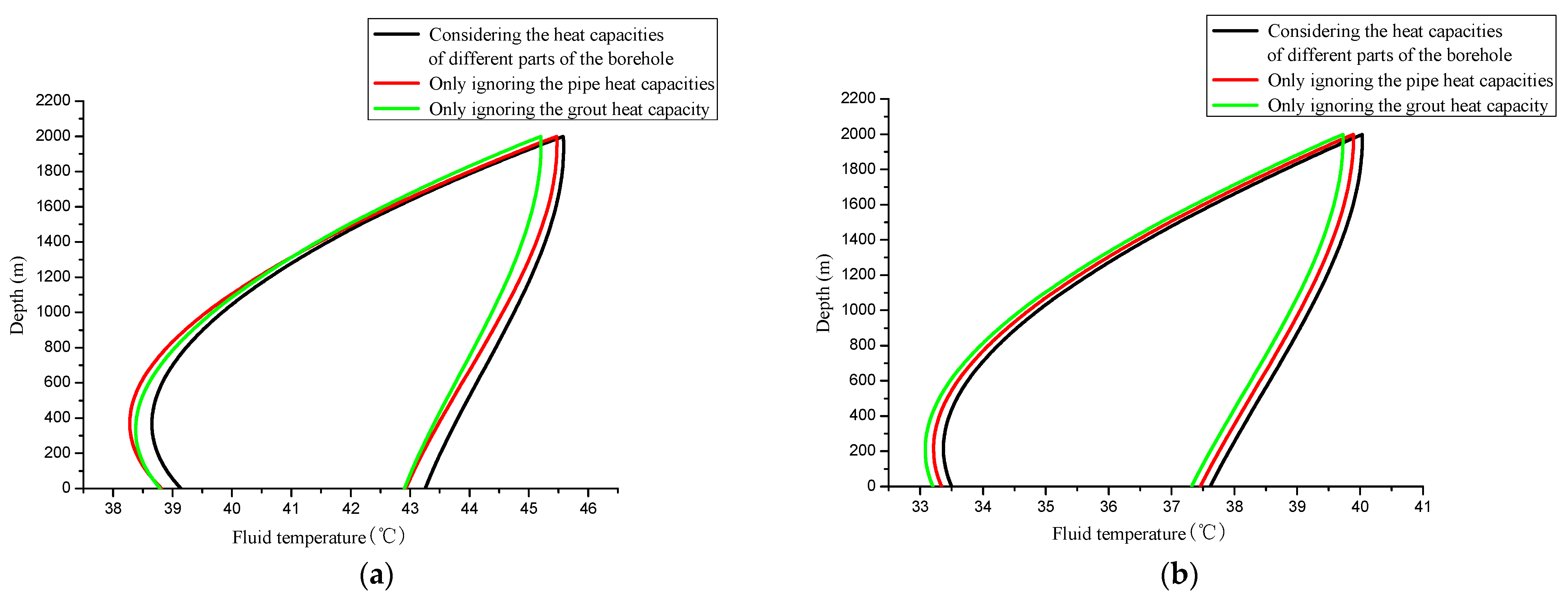
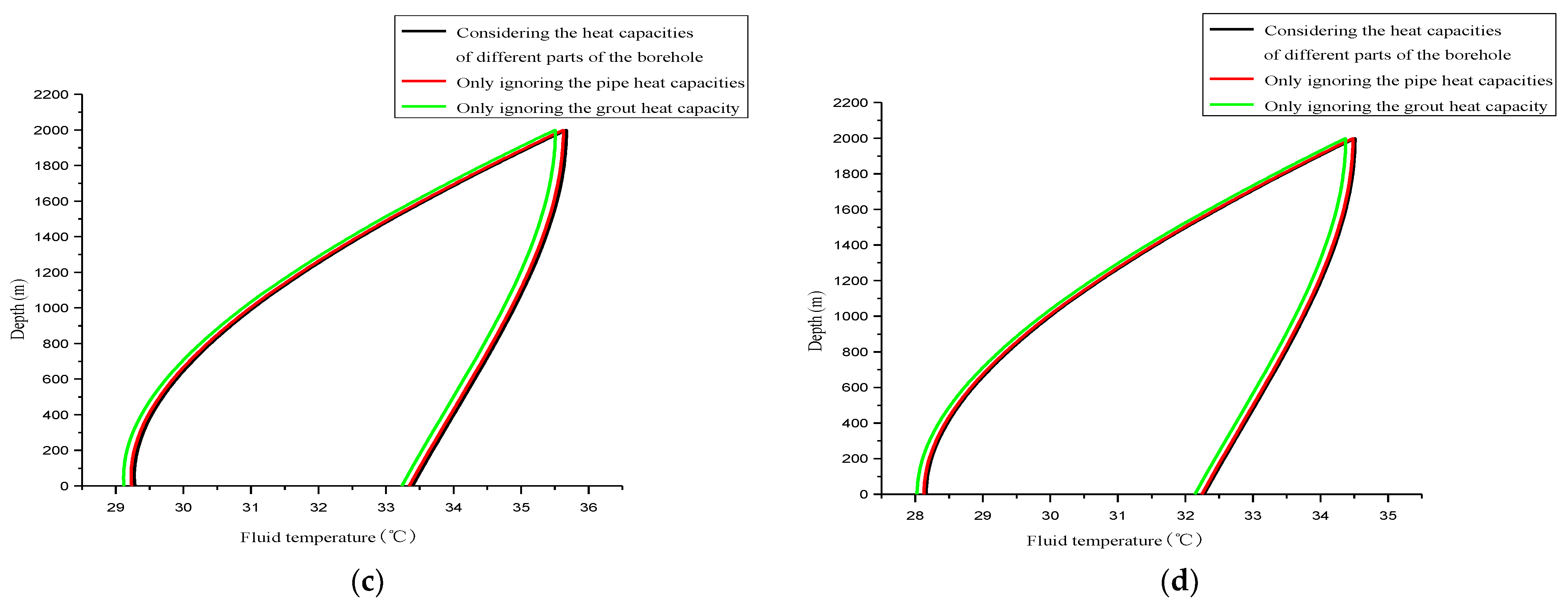
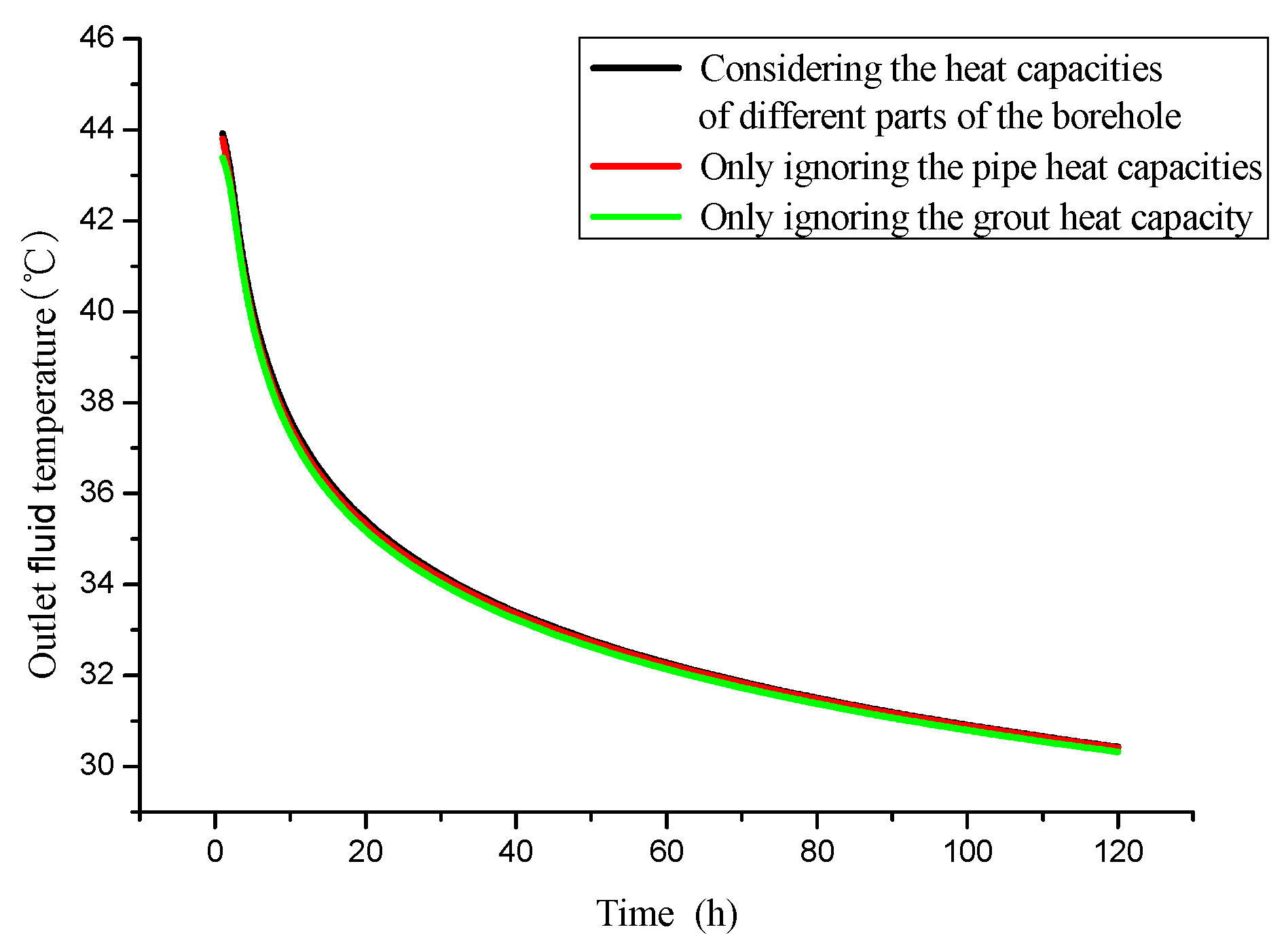
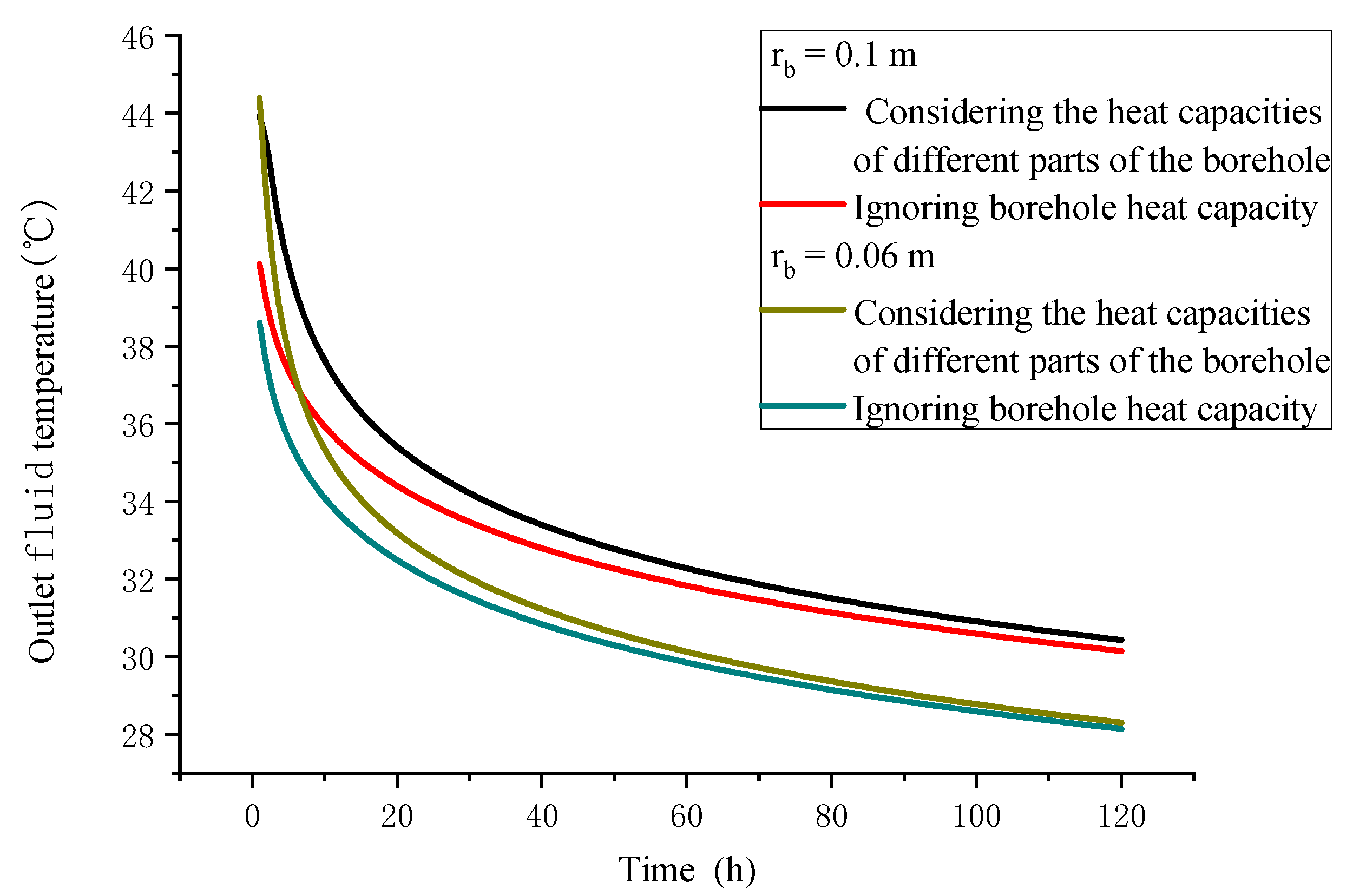

| Parameter | Symbol | Value |
|---|---|---|
| DCBHE length | L | 2000 m |
| Borehole radius | rb | 0.1 m |
| Inner radius of the internal pipe | ri | 0.03766 m |
| Outer radius of the internal pipe | ro | 0.045 m |
| Inner radius of the external pipe | Ri | 0.08263 m |
| Outer radius of the external pipe | Ro | 0.0885 m |
| Thermal conductivity of the internal/external pipes | λp | 0.5 W·m−1·K−1 |
| Volumetric heat capacity of the internal/external pipes | (ρc)p | 1.85 × 106 J·m−3·K−1 |
| Thermal conductivity of the grout | λg | 0.73 W·m−1·K−1 |
| Volumetric heat capacity of the grout | (ρc)g | 3.8 × 106 J·m−3·K−1 |
| Thermal conductivity of the soil | λs | 3.25 W·m−1·K−1 |
| Volumetric heat capacity of the soil | (ρc)s | 2.24 × 106 J·m−3·K−1 |
| Thermal conductivity of the fluid | λf | 0.59 W·m−1·K−1 |
| Volumetric heat capacity of the fluid | (ρc)f | 4.19 × 106 J·m−3·K−1 |
| Mass flow rate of the fluid | M | 11.6 kg·s−1 |
| Temperature of the soil surface | Tsur | 15 °C |
| Geothermal gradient | a | 0.03 °C·m−1 |
| Heat input rate | Q | −200,000 W |
Publisher’s Note: MDPI stays neutral with regard to jurisdictional claims in published maps and institutional affiliations. |
© 2022 by the authors. Licensee MDPI, Basel, Switzerland. This article is an open access article distributed under the terms and conditions of the Creative Commons Attribution (CC BY) license (https://creativecommons.org/licenses/by/4.0/).
Share and Cite
Wang, C.; Fang, H.; Wang, X.; Lu, J.; Sun, Y. Study on the Influence of Borehole Heat Capacity on Deep Coaxial Borehole Heat Exchanger. Sustainability 2022, 14, 2043. https://doi.org/10.3390/su14042043
Wang C, Fang H, Wang X, Lu J, Sun Y. Study on the Influence of Borehole Heat Capacity on Deep Coaxial Borehole Heat Exchanger. Sustainability. 2022; 14(4):2043. https://doi.org/10.3390/su14042043
Chicago/Turabian StyleWang, Changlong, Han Fang, Xin Wang, Jinli Lu, and Yanhong Sun. 2022. "Study on the Influence of Borehole Heat Capacity on Deep Coaxial Borehole Heat Exchanger" Sustainability 14, no. 4: 2043. https://doi.org/10.3390/su14042043





